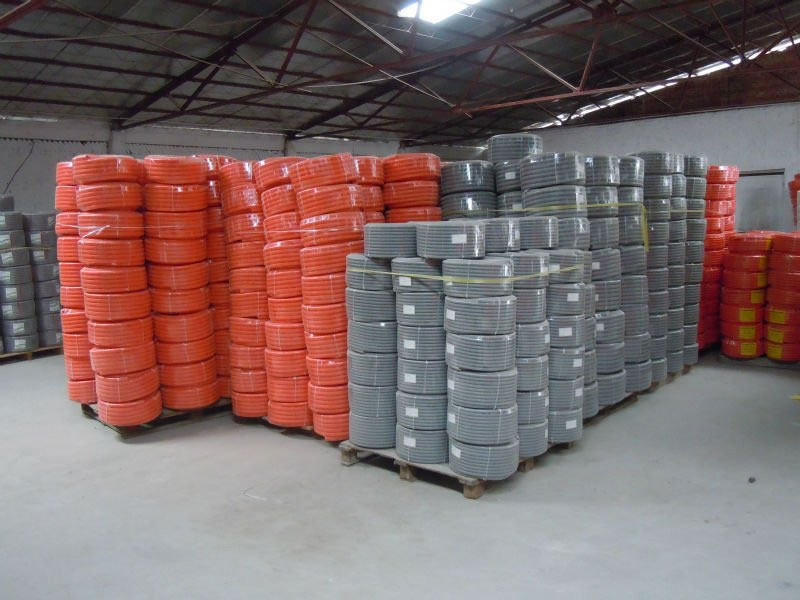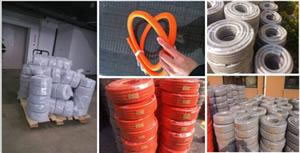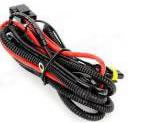
Fire is one of the major hazards to life and property. And electrical installations are perhaps one primary sources of generation and propagation of fire. Protection of cables and raceways against fire is therefore an important and primary consideration in the design and industry standards. Scientists and Engineers all over the world have been seriously concerned, about the behavior of electrical raceways under fire. Extensive studies and rigorous research into materials and manufacturing of Electrical conduits has led to the development of Fire retardant conduits. In the event of fire, the major reasons for destruction and loss are emission of corrosive gases and formation of dense smoke. Kalister Fire Retardant and Low smoke conduits offer effective resistance against propagation of fire and do not emit corrosive gases and smoke generated during fire is of negligible amount. Kalister LSFR Conduits are manufactured from superior quality raw materials and fire retardant Low smoke additives conforming to the international specifications. Fire Safety The most important flame retardance classification employed worldwide in the data technology, electrical and electronics industries is the UL94 rating drawn up by Underwriters Laboratories Inc., USA. The highest rating in qualitative terms is the "V-0” and this is attained by Kalister LSFR Conduits.
PVC is an inherently fire resistant plastic, the only exception among the general-purpose plastics, since it contains more than 50% of chlorine.
When PVC products are burned, hydrogen chloride gas resulting from thermal cracking slows down the continuous combustion reaction and prevents burning progress by warding off the PVC product surface from oxygen in the air. The gas is also detectable by its – highly unpleasant - odour at concentrations well below those that could be harmful to health. This feature allows early detection of a fire. Gaseous hydrochloric acid is, for example, much less hazardousthan carbon monoxide, which is narcotic and has no smell and can rapidly lead to paralysis and death.
Other advantages of PVC are that it releases less combustion heat than other plastics - hence contributes less to maintaining and spreading fire – and produces no or very few flaming droplets or debris. Burning PVC yields an expanded carbonaceuous structure usually called 'intumescence’. This structure forms a thermal barrier protecting underlying parts. In some cases, such as pipes, PVC can even prevent fire spreading by blocking the orifices through walls or floors.
Since PVC is highly fire resistant, it is widely used in exterior construction materials such as window profiles, siding boards, or interior housing materials, such as wall-covering and flooring. It is also used in industrial facilities such as tanks, ducts, parting strips, or for sign boards, corrugated boards, and cable coverings. There may be many ways of evaluating the fire retarding properties, but the oxygen index can be used for the evaluation with a comparatively high precision and reproducibility of the results. It represents the minimum oxygen concentration required for the test piece to continue burning in mixed gas of oxygen and nitrogen. When the value is higher, the fire retarding property is higher. Since the oxygen concentration in the air is 21%, a plastic with an oxygen index greater than 22 has self-extinguishing property, while a plastic with oxygen index smaller than 21 is flammable.
Fire resistant properties can also be given to olefin plastics such as PE and PP by cross-linking treatment or by adding large quantities of fire retardants, but it would be difficult for these plastics to compete with the versatility of flexible PVC products whose softness can be controlled with ease and which can be easily recycled.
It has excellent performance of waterproof, insulation and tensile property.
2. The counter-lock structure provide a powerful tensile resistance, hard to break and deform
3. High flexibility
Using method: Inserting the wire or cable into the conduit and the equipped with matched connector
Power plant, Power transmission system, communication system, building factory, railway, train, transportation system project, air conditioner, various machines, automates controlling plant. And protecting the electrical wire or cable outside the construction and plant.
Advantages( Corrugated conduit)
• Good insulation characteristic: good insulation property, high anti- current puncture strength, can resist 25kV voltage
• Great impact-resistance, can be buried in concrete, resist compression, impact
• Good fire-resistant: high oxygen value, good combustion-resistance, self extinguishing
• Moisture-resistant to acids, alkalis
• No rust occurs like metal pipe, resist acids, alkalis, and oil
• Biotic resistance, PVC conduit pipe with no smell attracting rodent, will not suffer from biotic attack
Wire jacket pipe, in fact, also called insulating sleeve, is a composite insulating materials of new type of composite material tube, it with resin as the matrix and the other reinforced composite and the insulating bushing for wear with wire and cable protection, it is referred to as the wire protective sleeve. It has the characteristics of strong resistance to pressure, light weight, smooth inner wall, small friction coefficient, easy to wear with electric wire, not damage wire. Move, transport to the metal pipe and cement pipe easily, convenient. Installation is simple, easy and labor-saving. Strong corrosion resistance, insulation, non magnetic, acid and alkali resistance, flame retardant, antistatic.
fire resistant pvc conduit
flexible corrugated tube conduit for fire resistant
Fire Resistant Pvc Pipe
Highly Reliable Low Smoke Flame Retardant Conduits
Fireproof plastic electrical conduit
Fire Resistant Conduit

